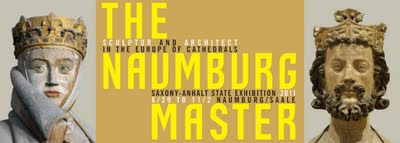After the war, Bamberg was situated in the West, whereas Naumburg was in the East. The two pieces of sculpture were separated and became one of the many reminders that Germans were divided politically but not in their hearts.
With Germany's reunification in 1990, the Rider and Uta have united again. I last visited Uta, regarded as one of the most important works of German Gothic art, in 2003. On that occasion, I read a text written in 1928 by Gertrud Bäumer, a well-known German feminist and not considered to display an excessive Germanness: Uta derives from a relationship with the German woods, with long brutal winters full of loneliness and horror in the dark, long waiting and longing, spring tempest over melting snow, hard and harsh but soaked with inner balminess. Don't worry; the German text is as incomprehensible as my English translation.
The other day I read in the German weekly Die Zeit about an exhibition called The Naumburg Master - Sculptor and Architect in the Europe of Cathedrals. The article showing Uta's picture was headed Très Deutsch, and indeed I expected the old story that this woman is very German. The French très should, however, have warned me, for the article revealed the crushing news that the creator of this German Gothic masterpiece possibly was French!
The whole story I found on the Naumburg Exhibition website: The sculptors and stonemasons associated with the name "Naumburg Master "had an outstanding reputation throughout medieval Europe. From the 1220s on, German masters trained in the sculpture workshops of the Northern French cathedrals situated in Île de France, Champagne, and Picardie. Their journey to Germany took them across the borders of the French kingdom via Mainz to Naumburg and Meissen. Their legacy is a body of work that is of outstanding quality and worldwide importance. The sculptures of the west rood screen in Mainz Cathedral, the relief depicting the sharing of St. Martin's coat in Bassenheim, the tomb slab of the Ritter von Hagen in Merseburg Cathedral, the statues in the choir and the octagon chapel of Meissen Cathedral and above all the unique west choir of Naumburg Cathedral with the Passion reliefs of the rood screen and the statues of the founders (Uta!) are impressive examples of the outstanding quality of workmanship from these medieval masters.
When looking at the Strasburg cathedral, Goethe once admired the Gothic style as native German, but he was severely mistaken. Gothic architecture was born in France; it splashed over the Rhine River and subsequently spread over Europe. In the beginning, German stonemasons educated in the Romanesque style tried to imitate the new French style. The result can still be seen when looking at Freiburg's Münster church. Not until they called in the masters from the other side of the Rhine did the construction of the windows get the lightness of style so admired at the Reims cathedral.
So eventually, it's European. The Naumburg Exhibition, in fact, is under the joined patronage of our Chancellor and France's President.
 |
| ©Wikipedia/Berthold Wener |
*



Informative, engaging and very well written. Regards, Bulent
ReplyDelete